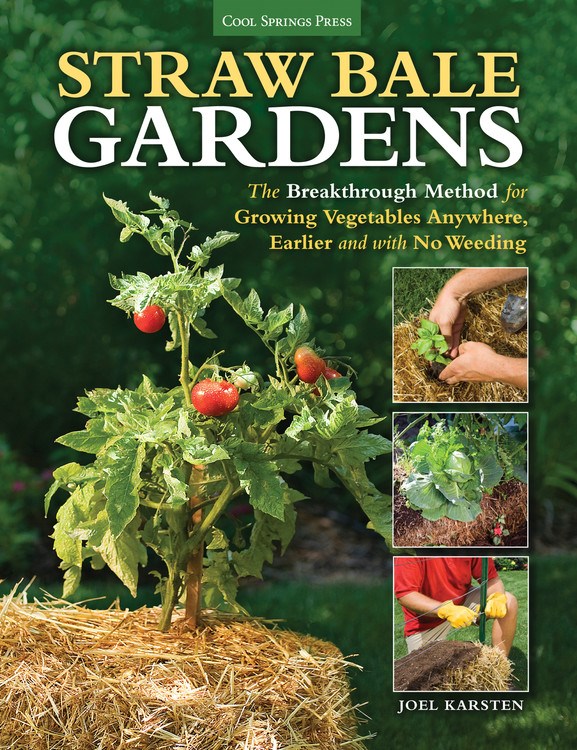How to get started with straw bale gardens
Planting seeds in straw bales? Really? If the idea of growing your garden without digging in the soil might sound a bit counterintuitive. But if you long to enjoy fresh produce, fruit or flowers grown yourself there is an alternative to digging in dirt. In his book Straw Bale Gardens, Joel Karsten takes you step-by-step through the process of establishing, planting, maintaining and harvesting your own straw bale garden.
This excerpt from his book looks at what to think about when starting your own straw bale garden.

Any location can work
A straw bale garden can be established virtually anywhere, as long as the location selected gets full sun and water is accessible. In the SBG world, the soil that you may be “cursed” within your backyard is irrelevant to your success. I am familiar with several Straw Bale Gardens that have been grown on top of the asphalt in the corner of a parking lot, and the gardens grew beautifully.
What’s under the bales is completely irrelevant to this method of gardening because the roots establish in the bales, not in the soil. The bales can rest on any surface, including grass, packed gravel, loose pea rock, and even solid concrete.
If the garden is established on top of contaminated soil, put down a layer of landscape fabric beneath the bales. This will prevent any roots from possibly growing through the bales and into the surface soil and absorbing anything that could be harmful to the plant or to those who eat the crop grown. The soil acts only as a drain for water that runs out of the straw bales and as a mechanism to hold the bales in place.
If the area chosen to set up the Straw Bale Garden has a slight slope, this can be advantageous because it will keep water from pooling underneath the bales and making the aisles between the rows muddy after a heavy rain. As much as possible, avoid any area where water tends to stand after a rainfall. Mud puddles are not fun to stand in while you are tending your garden.
Handling Slope
Straw Bale Gardening on a slope is definitely possible. Position the bales so they run up and down the slope rather than across the hillside. If you turn them sideways the bales can easily tip over, and that could be a disaster if it happened at the wrong time during the season.
Use a few wood stakes next to any bales that may be precariously perched on a hillside. It will let you sleep well when the wind blows in the wrong direction, without concern that you’ll wake up to a horizontal garden disaster.
Plant It Where the Sun Shines
It is vital that the site selected for the garden has full sun exposure, with a minimum of six to eight hours of sunlight each day. Less than full sun will limit the vegetable crops that will grow well, and will prevent other crops from achieving maximum yield.
Limiting sunlight not only reduces photosynthetic activity, slowing plant development and ripening, but it also slows the drying of morning dew from the leaves of your crops. Wet leaves spread disease! If a leaf has even a speck of fungus, mold, virus, or bacteria present on the leaf, the diseased leaf can act like a petri dish and in a humid environment the surface can rapidly reproduce and spread that disease. Care should be taken to keep leaf surfaces as dry as possible for good overall plant health and better crop production.
If possible, pick a location that allows for morning sun exposure so that leaves dry early in the day. Halting the spread of fungus, mold, virus, or bacterial infections on plant leaves can be as simple as keeping the leaves dry. Make it your practice to prune off any diseased leaves whenever you see them. This will help limit the spread of problems to other plants.
Productivity vs. Creativity
The most productive and efficient garden will have single file rows of bales positioned end to end. This allows easy access to the plants on the surface from either side of the row and maximizes the air circulation around plants and leaf surfaces exposed to direct sunlight. If space is limited it is possible to run two rows side by side. This way, bales will still be accessible from the outside.
Some people like to line up their bales in a variety of creative ways, making squares or boxes around squares, or zigzag bales to make a really funky design. This will work okay, but I do not recommend putting any more than two rows side by side. Always allow for a minimum four feet of space between each row of bales.
More than four feet is best if you have the space available and can use it to stretch out the distance between rows. Four feet will allow a wheelbarrow or garden wagon to move easily up and down between the rows.
This, “Straw Bale Garden” is excerpted from Straw Bale Gardens by Joel Karsten. Used with permission of the publisher, Cool Springs Press.
